The Battle of Midway Roundtable Opening Remarks

Welcome to the August issue of the Battle of Midway RoundTable. The announcement that the E/V Nautilus would be returning to the Battle of Midway ships earlier this month was a welcome surprise. I thought we would have had videos earlier, but they finally surfaced on the 19th. The images are fascinating in so many ways. When the ships were discovered 25 years ago the images were good and these are as good or better. And our members were just as excited as the number of emails started to arrive yesterday. A few are listed below. Click on the picture and it will take you to the video.
But that's not all. We also have a book review and a follow up to the shoulder harness question and something I hadn't thought of previously, that being how were the PBY's with radar at Midway used and did the radar in the PBY's have any effect on the battle.
I know that the 4 PBY's that attacked the Japanese transport fleet found the Japanese ships in the dark using their radar sets. They even scored a hit with a torpedo on the Japanese oiler Akebono Maru although the damage was not severe. The question remains that at least 4 Catalinas were equipped with ASE (naval designation) radar during the battle but were there any others? I don't recall reading that any of the PBY's that searched for the Japanese fleet on the morning of the 4th were equipped with radar. I may not remember having read it anywhere, so I'll have to give it some attention and see if there is any mention of whether any other PBY's were so equipped as the 4 that made the night attack.
And there is more. So, sit back, relax and watch the video captures of the three ships.
Until next month.
Yorktown revisited 25 years later
19 September 2023 From Barrett Tillman
The same folks who found Akagi have revisited Yorktown.
E/V Nautilus Reveals USS Yorktown for First Time in 25 Years
19 September 2023 From Robert Rheinboldt
New footage shows historic World War II shipwrecks in the Pacific
https://www.bbc.co.uk/news/world-us-canada-66850193
Yorktown, Kaga and Akagi. Wonder if there will be a show either on PBS or elsewhere.
Regards
Robert Rheinboldt
20 September 2023 From Howard Ady III
In case you missed this discovery!
Vty
h
Midway pics of sunken ships.
20 September 2023 From Rich Frank
Finally got a chance to view this by connecting my laptop to a full TV screen and turning out the lights to get the best quality images.
The images were remarkable to incredible. But I was very disappointed in the commentary. After all the preparations and expense for the mission, I would have thought they could have had much more well-informed historians and "ship nuts" connected in who could explain much more accurately the background and the details of the images.
Why wasn't Chuck Haberlein, among others, standing by even remotely to share his knowledge?
I know the folks they did have were doing their best, but what a missed opportunity.
Rich, with regrets
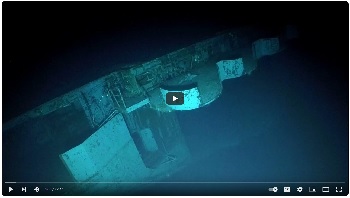
Akagi Wreck Survey
19 September 2023
From Frank Raus
Identity of massive WWII shipwreck confirmed when team finds name still etched on bow
Miami Herald
MARK PRICE
September 19, 2023 at 8:43 AM
An international team working to confirm the identify of a World War II shipwreck made a “haunting” discovery when it found the ship’s name embossed on the bow, despite being on the Pacific Ocean floor for 81 years.
The team, led by Ocean Exploration Trust, reports the massive wreck is that of the Imperial Japanese Navy aircraft carrier Akagi, which was scuttled during the Battle of Midway in 1942.
“It’s rare when a ship actually tells you its name,” the crew reported from the seafloor. “This is a pretty important moment in this exploration.”
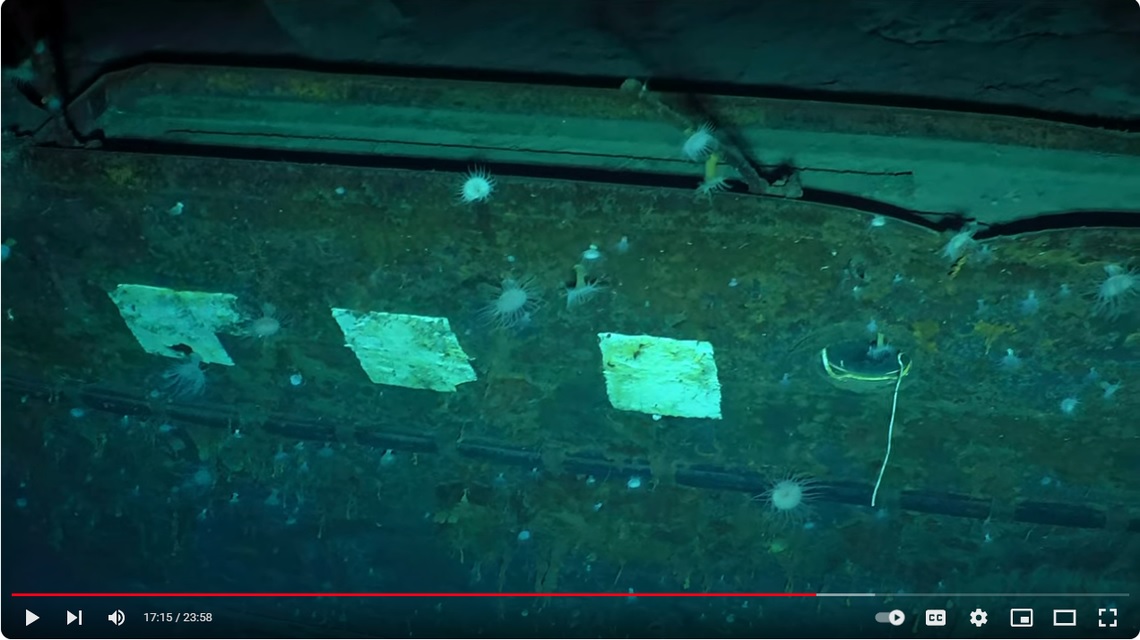
The name of the Japanese Navy aircraft carrier Akagi had been covered in paint, perhaps to hide its identity from U.S. Forces, but the letters were seen outlined in the metal hull, officials say.
The name of the Japanese Navy aircraft carrier Akagi had been covered in paint, perhaps to hide its identity from U.S. Forces, but the letters were seen outlined in the metal hull, officials say.
A giant chrysanthemum emblem — likely once painted gold — was found on the bow, noting the 855-foot vessel was property of the Japanese emperor, officials said. Deciphering the name of the vessel was made all the more challenging because the symbols had been covered in white paint before going into battle, perhaps to keep U.S. forces from identifying it, the team reports.
However, a remotely operated camera found the outline of the original Japanese characters were stenciled into the metal beneath the eroding paint, officials said. “This feels especially sacred and important,” one team member said in video of the discovery. “Such an honor to bear witness to this.”
Large guns were also found around the ship, their barrels still pointed at targets that no longer exist. The guns are additional proof of the wreck’s identity, because the Akagi was a fully armed battle cruiser that was later converted into an aircraft carrier, historians say. The expedition began Sept. 8 on the Exploration Vessel Nautilus and counts as first attempt at a visual survey of the wreck, which rests within Papahānaumokuākea Marine National Monument, about 980 miles northwest of Hawaii. The crew will continue mapping the seafloor in the region through Sept. 28.
A remote camera spent 14 hours circling the wreck, revealing catastrophic damage resulted when a U.S. pilot dropped a 1,000-pound bomb near an airplane elevator. The bomb penetrated the deck and detonated in the hangar among “the fully armed and fueled torpedo bombers being prepared for an airstrike against the American fleet.” Many of the 267 crew members who died were trapped below the fires in the engineering space, historians say.
“Before sunrise on June 5, (1942), as raging fires continued to burn aboard Akagi, (Japanese) destroyers Arashi, Hagikaze, Maikaze, and Nowaki each fired one torpedo into the former flagship, sinking it bow first,” Nautilus reports.
It was scuttled to keep it from falling into the hands of U.S. forces, officials say. The team discovered what remained of the flight deck had been folder over by repeated explosions below decks, and intense heat caused metal to warp. The top half of the tower or superstructure that sat atop the fight deck was also gone.
No aircraft were found on or around the ship.
The wreck was originally discovered during a mapping survey in 2019 that involved U.S. Navy participation, and was long suspected to be the Akagi, officials said. “However, the carrier was not investigated at that time,” the Ocean Exploration Trust says.
Akagi was one of 3 WWII wrecks the expedition visited for an “archaeological assessment” at the site of the Battle of Midway. The USS Yorktown was among the ships.
Here is a link to the youtube video of the survey.
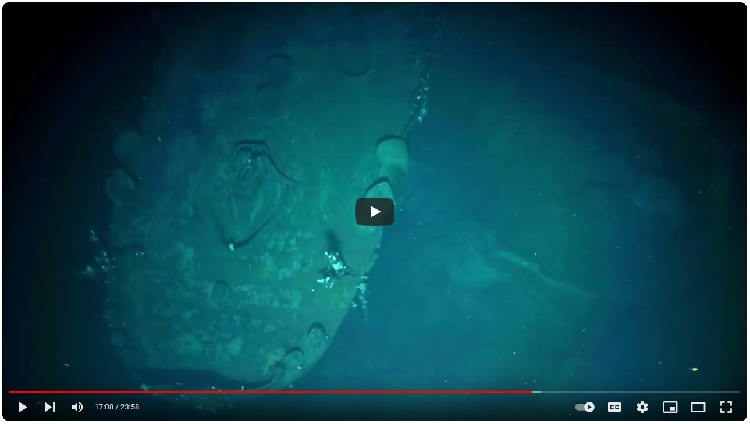
Kaga Wreck Video
19 September 2023 Editor
And while were at it here is the video of the Nautilus looking over the Kaga.
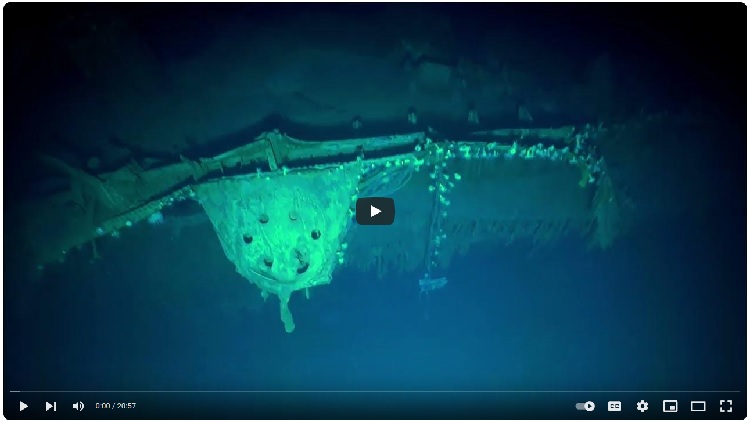
Book Review - Carnage and Culture - Victor Davis Hanson
28 August 2023 From Thomas Rychlik

Hat tip to Chuck Race. Victor Davis Hanson’s Carnage and Culture subtitled: Landmark Battles in the Rise of Western Power, is an excellent look at how Western culture influenced warfare among a great many other things. He devotes chapters to the Battles of: Salamis, Gaugamela, Cannae, Poitiers, Tenochtitlan, Lepanto, Rorke’s Drift, Midway, and the Tet Offensive. Each battle has a focus to it. For example: Decisive Battle, Citizen Soldiers, Landed Infantry, Technology and the Wages of Reason, The Market - or Capitalism Kills, Discipline - or Warriors Are Not Always Soldiers, Dissent and Self-Critique. As a military historian he writes on ancient and classical warfare. His use of quotes from ancient historians such as Hippocrates, Xenophon, Aeschylus, Herodotus, and many others are quite insightful and educating. The book was completed in 2000 and published in 2001, so unfortunately many of the things we have learned about Midway since then are not discussed. This is a shame because I
would be very interested in how VDH would have considered these new-found issues, especially since the focus in Chapter Nine was on “Individualism” and he analyzed Midway from that perspective. Because this is the Midway Roundtable, I will confine my review to his discussion of Midway.
There are errors in the Midway Chapter that are not due to more recent scholarship and, because I knew next to nothing about the other battles, made me concerned knowledgeable historians on those battles might have found similarly concerning. For example: the Captain of the Soryu was not an Admiral, nor was Admiral Yamaguchi the Captain of the Hiryu. On page 343 he says Lieutenant Commander John C. “Jack” Waldron issued his final mimeographed guidance to his men on June 5. I didn’t find these types of errors to be too serious. However, there were more serious ones that were unfortunate. Among some of these were: Torpedo Three was closely escorted by Thatch’s six Wildcats, although a number of the 36-43 Zeros stayed with VT-3 a goodly number were focused on Thatch and his F4Fs. The Midway based TBFs were flown by detached Torpedo Eight (Navy) pilots and not Marines. Although he discusses the VMSB-241 Vindicator attack, he neglects to include Major Henderson’s SBD attack on Kido Butai.
He does not attribute the lost contact among the Enterprise Air Group’s squadrons to Spruance’s decision to signal McClusky to depart before Torpedo Six was launched. Nagumo did keep a reserve of half his aircraft loaded for anti-ship targets when he launched the other half of his aircraft against Midway that morning.
The book has some very interesting statistics on Japanese and American war production and the irreplaceable investment of millions of days of precious skilled labor and resources that were lost when we sank their four frontline aircraft carriers with their complement of aircraft and a hundred of their best carrier pilots. VDH also compares the number of participants at Midway with Salamis (480BC) and Lepanto (1571).
VDH devoted 55 pages to Midway and an entire section of 10 pages to “The Annihilation of the Devastators.” He accurately describes the weaknesses of the TBD and it’s unreliable and slow torpedo, although he does not get into the specifics of how these faults affected the tactics of torpedo attack. He credits John Waldron’s instincts in anticipating Kido Butai’s change in course and finding the Japanese but did not discuss the outbound heading of the Hornet Air Group and Waldron’s conversation with Commander Ring prior to leading Torpedo Eight to the southwest. These points were discussed by Lundstrom in 1984, Cressman in 1990, Weisheit in 1993, well prior to publication of C&C. He compares flying a loaded Devastator at Midway “to driving a Ford Pinto in the slow lane, with its trunk and seats loaded with dynamite as other, far faster drivers shot at it with machine guns as they passed by.” He quoted Commander Genda “as likening the Devastators to tired mules.” A quote I had never seen
from him before. In discussing Lieutenant Commanders Massey, Lindsey, and Waldron: “Neither skill nor courage meant anything when piloting an obsolete Devastator.”
Pointing out that 35 of 41 Devastators were shot down attacking the Japanese carriers and that most of the pilots had never taken off armed with a torpedo from the deck of an aircraft carrier, he notes this loss rate would be scarcely comprehensible under the protocols of contemporary American military practice, in which troops enjoying overwhelming technological, material, and numerical superiority are sometimes not committed to battle out of fear of losing a handful of combatants. VDH further stated: “The American military was later aghast over the use of Japanese kamikaze planes in the last year of the war; but the orders for the Devastator attacks at Midway were themselves little more than suicidal.” As discussed on the Roundtable the weaknesses of the TBDs and torpedoes were well known within the Naval Aviation community at this time. Aboard Hornet - Waldron and Mitchell, and on Yorktown - Massey and Thatch, all argued with their Commanders for sufficient close fighter support to
the TBDs to improve the odds somewhat. The Intelligence Officer that briefed Torpedo Three before the battle stated that if only three planes of the squadron got close enough to launch their torpedoes, they would have accomplished their mission. Inherent in all these discussions was the assumption that the torpedo bombers would attack in close coordination with the dive bombers, which of course didn’t happen.
His depiction of the horrors of being aboard the Japanese aircraft carriers as their bombs, torpedoes, and aircraft exploded when hit by the bombs of our dive bombers was quite descriptive and he compared the lack of options the sailors had when compared to soldiers being shelled or bombed in land warfare: literally there was no escape from being burned alive, suffocating inside the ship as the decks above them turned cherry red, or jumping off the ship to drown. In a discussion on the size of the Japanese armada and the intricacies of the Japanese plan, VDH finds it odd that the sacrifice of fewer than a hundred green American torpedo pilots would ruin all of Yamamoto’s elaborate ideas of annihilating the American Pacific fleet. Amen to that!
VDH points out that the imperial fleet’s vast numerical superiority and more experienced crews were overcome by a much smaller American force where personnel of all ranks were unusually innovative, even eccentric, and always unpredictable. Most Americans were unafraid to take the initiative to craft policy when orders of superiors were either vague or nonexistent, which was antithetical to the protocols in the imperial fleet and which mirrored prewar Japanese society. Again, had VDH been aware of the prelaunch meeting on the bridgewing of the Hornet and Waldron’s breaking radio silence in an effort to convince Ring to follow him, he might have added poorly formulated or miscalculated to vague or nonexistent orders. If the focus was on Individualism, Waldron personified that descriptor. I also would like to know what he would have said about Eugene Lindsey leaving sickbay the morning of June 4 to lead his squadron, having been significantly injured when he crashed a week before.
VDH points out the only reason for American weapons inferiority at Midway was a general complacence following World War I, fueled by the country’s utopian ideas of world peace, by its isolationism and by an economic depression. He expounds that in four critical ways the American faith in individuality rather than group consensus, spontaneity rather than rote, and informality rather than hierarchy proved decisive at Midway. These critical ways were: The Code Breakers, The Repair of the Yorktown, Flexibility in Command, and The Initiative of the Pilots. I leave you with perhaps his most insightful comment:
“To the modern American at the millennium, these carrier pilots of more than a half century ago – Massey, Waldron, and Lindsey last seen fighting to free themselves in a sea of flames as their planes were blasted apart by Zeros – now appear as superhuman exemplars of what constituted heroism in the bleak months after World War II…doomed fighters who were not all young eighteen-year-old conscripts, but often married and with children, enthusiastic rather than merely willing to fly their decrepit planes into a fiery end above the Japanese fleet, in a few seconds to orphan their families if need be to defend all that they held dear. One wonders if an America of suburban, video--playing Nicole, Ashleys, and Jasons shall ever see their like again.”
All in all this book educated me on how warfare changed over the millennium and associated Midway with these other pivotal battles. It was well worth the cost and effort. One final note. In 2017 VDH wrote an article in Investor’s Business Daily titled “Lessons From The Battle of Midway” that summarizes his Chapter on Midway in C&C. It is also well worth reading.
Sincerely,
Thomas Rychlik
PBY Radar at Midway
29 August 2023 From Howard Ady III
From John Sterling
Howard, Did your Dad detect the Japanese fleet at Midway utilizing radar?
John,
It was a visual sighting when the dense clouds parted. He was only able to avoid the Japanese fighters thanks to the cloud cover else his plane would have [been] in the Pacific.
Vty, h
That’s what I thought, visual sighting. Embarrassingly, I just ran across a clip put out by my own museum that says the Japanese fleet was discovered via PBY mounted radar. I’ll send you the clip.
John
Thx & glad to see it!!!
I note that when my dad & I went to Pensacola for his videotaped interview by the retired Admiral in the early 80s, there was a problem with the AV and the recording was unusable. Sad they did not do a check before the interview.
Aloha & Mahalo for sending this link!
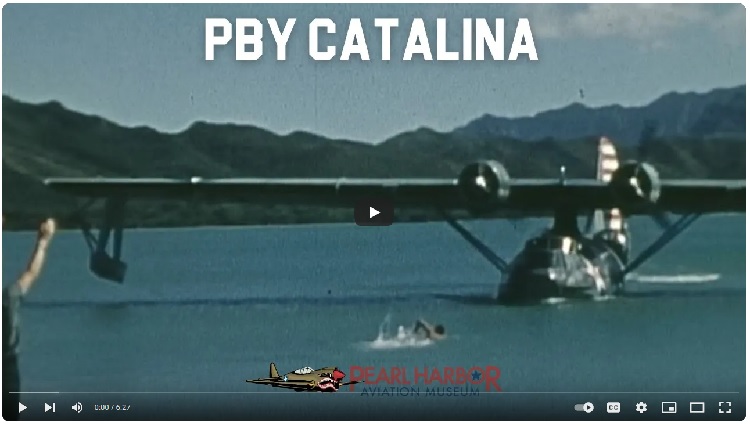
Aloha! h
Does the clip reflect accuracy concerning PBY radar at Midway?
Without speaking with the Pearl Harbor Aviation Museum curator on the subject of radar at Midway, it seems he is putting out in his clip that there was a sidebar involving radar equipped PBYs. While your Dad was involved in visual contact, it would appear to me that the Navy, according to this radar info, had a certain amount of hope and confidence that they could insert an offensive move in PBY radar. Surely, guys like your Dad would have eventually gained knowledge of this either during or after the war.
John
John
Aye, aye!
Aloha!
Shoulder Harness
18 August 2023 From Barrett Tillman
Ref. F4F shoulder harnesses and Rich Leonard's contribution. I remember his dad saying that VF-42's original experiment involved a strap around the chest, almost like a bra, but of course heavier. No doubt that arrangement interfered with turning the torso to check the rear hemisphere.
The shoulder harnesses I used in WW II aircraft had pull tabs that allowed easing the tension for whatever reason (usually searching the rear hemisphere) but could be cinched up in a very few seconds. Similar arrangement in "fighterjets" such as F-15 and A-6.
Barrett
Article on Midway
17 August 2023 From John Wedo
After eight years in the Air Force and 30 at Lockheed-Martin, I retired from Lockheed-Martin as a system engineer in 2011. Since then, my Penn State college roommate, Terry Salada, and I have conducted research into the Civil War. We have had articles reviewed and posted to the General Meade Society website, which link follows:
Link
Terry and I have science backgrounds, and we think that we have covered our topics thoroughly and scientifically and have reached interesting conclusions not normally considered. We also make numerous comparisons to situations in other wars, notably WW2, to shed light on the Civil War situation.
We have branched out into our other area of interest, WW2 and we have written a paper on Midway entitled "Midway by the Numbers." Its theme is that the numbers involved in the battle are relatively small compared to other battles and are therefore easy to grasp.
Our problem is that our circle of reviewers is oriented to the Civil War and not one is oriented to WW2, let alone Midway. In addition, we know where to submit Civil War papers (see above), but we have no idea if there is any forum for amateur papers on Midway. If any of your members might be interested in this topic, please inform.
A sample of the paper is attached for your perusal. I can send the entire paper if you wish.
We are currently working on a paper analyzing the IJN Battle Report for Midway.
Thank you for your time.
John D. Wedo (hic/haec/hoc), Retired
Sample of Midway Article
Announcements and Questions
Midway Library
17 August 2023 From Bob Grove
I have read a great deal about the BOM. This reading has covered all of the major works and some of the minor books. Would the group make a list of titles that they view as must reads. I have enjoyed the group and hope you keep up the great work and scholarship.
Bob Grove
We do have a library of books on the Battle rated from 1st through 47 or so. There are a few new ones that I need to add but the top few on the page are the most significant. Is this what you're looking for?
http://www.midway42.org/Library.aspx
18 August 2023 From Bob Grove
I did not know you had already placed a list. That is super helpful. I guess I was wondering if there were things I had not read. After you find the time to update the list, it might be advantageous to send it out to the round table again.
Thanks for all you do
Bob Grove
|